The Chlamydomonas mating type plus fertilization tubule, a prototypic cell fusion organelle: isolation, characterization, and in vitro adhesion to mating type minus gametes
- PMID: 9199169
- PMCID: PMC2137821
- DOI: 10.1083/jcb.137.7.1537
The Chlamydomonas mating type plus fertilization tubule, a prototypic cell fusion organelle: isolation, characterization, and in vitro adhesion to mating type minus gametes
Abstract
In the biflagellated alga Chlamydomonas, adhesion and fusion of the plasma membranes of gametes during fertilization occurs via an actin-filled, microvillus-like cell protrusion. Formation of this approximately 3-microm-long fusion organelle, the Chlamydomonas fertilization tubule, is induced in mating type plus (mt+) gametes during flagellar adhesion with mating type minus (mt-) gametes. Subsequent adhesion between the tip of the mt+ fertilization tubule and the apex of a mating structure on mt- gametes is followed rapidly by fusion of the plasma membranes and zygote formation. In this report, we describe the isolation and characterization of fertilization tubules from mt+ gametes activated for cell fusion. Fertilization tubules were detached by homogenization of activated mt+ gametes in an EGTA-containing buffer and purified by differential centrifugation followed by fractionation on sucrose and Percoll gradients. As determined by fluorescence microscopy of samples stained with a fluorescent probe for filamentous actin, the method yielded 2-3 x 10(6) fertilization tubules/microg protein, representing up to a 360-fold enrichment of these organelles. Examination by negative stain electron microscopy demonstrated that the purified fertilization tubules were morphologically indistinguishable from fertilization tubules on intact, activated mt+ gametes, retaining both the extracellular fringe and the internal array of actin filaments. Several proteins, including actin as well as two surface proteins identified by biotinylation studies, copurified with the fertilization tubules. Most importantly, the isolated mt+ fertilization tubules bound to the apical ends of activated mt- gametes between the two flagella, the site of the mt- mating structure; a single fertilization tubule bound per cell, binding was specific for gametes, and fertilization tubules isolated from trypsin-treated, activated mt+ gametes did not bind to activated mt- gametes.
Figures
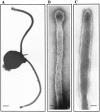




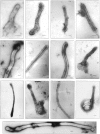


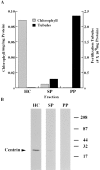
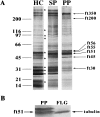
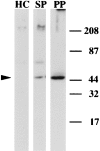

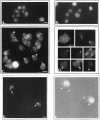
Similar articles
-
The Chlamydomonas Fus1 protein is present on the mating type plus fusion organelle and required for a critical membrane adhesion event during fusion with minus gametes.Mol Biol Cell. 2003 Jun;14(6):2530-42. doi: 10.1091/mbc.e02-12-0790. Epub 2003 Mar 7. Mol Biol Cell. 2003. PMID: 12808049 Free PMC article.
-
Isolation and in vitro binding of mating type plus fertilization tubules from Chlamydomonas.Methods Mol Biol. 2008;475:213-22. doi: 10.1007/978-1-59745-250-2_12. Methods Mol Biol. 2008. PMID: 18979246
-
Elongation of the fertilization tubule in Chlamydomonas: new observations on the core microfilaments and the effect of transient intracellular signals on their structural integrity.J Cell Biol. 1983 Aug;97(2):522-32. doi: 10.1083/jcb.97.2.522. J Cell Biol. 1983. PMID: 6684125 Free PMC article.
-
Gametic cell adhesion and fusion in the unicellular alga Chlamydomonas.Methods Mol Biol. 2008;475:39-51. doi: 10.1007/978-1-59745-250-2_3. Methods Mol Biol. 2008. PMID: 18979237 Review.
-
Protein transport and signal transduction during fertilization in chlamydomonas.Traffic. 2003 Jul;4(7):452-9. doi: 10.1034/j.1600-0854.2003.00105.x. Traffic. 2003. PMID: 12795690 Review.
Cited by
-
F-actin homeostasis through transcriptional regulation and proteasome-mediated proteolysis.Proc Natl Acad Sci U S A. 2018 Jul 10;115(28):E6487-E6496. doi: 10.1073/pnas.1721935115. Epub 2018 Jun 25. Proc Natl Acad Sci U S A. 2018. PMID: 29941587 Free PMC article.
-
Mating-induced shedding of cell walls, removal of walls from vegetative cells, and osmotic stress induce presumed cell wall genes in Chlamydomonas.Plant Physiol. 2005 Oct;139(2):999-1014. doi: 10.1104/pp.105.065037. Epub 2005 Sep 23. Plant Physiol. 2005. PMID: 16183845 Free PMC article.
-
Species-specific gamete recognition initiates fusion-driving trimer formation by conserved fusogen HAP2.Nat Commun. 2021 Jul 19;12(1):4380. doi: 10.1038/s41467-021-24613-8. Nat Commun. 2021. PMID: 34282138 Free PMC article.
-
Calcium sensors of ciliary outer arm dynein: functions and phylogenetic considerations for eukaryotic evolution.Cilia. 2015 Apr 30;4:6. doi: 10.1186/s13630-015-0015-z. eCollection 2015. Cilia. 2015. PMID: 25932323 Free PMC article.
-
Gamete attachment process revealed in flowering plant fertilization.Plant Signal Behav. 2014;9(12):e977715. doi: 10.4161/15592324.2014.977715. Plant Signal Behav. 2014. PMID: 25517689 Free PMC article.
References
-
- Adair WS, Monk BC, Cohen R, Hwang C, Goodenough UW. Sexual agglutinins from the Chlamydomonasflagellar membrane: partial purification and characterization. J Biol Chem. 1982;257:4593–4602. - PubMed
-
- Berlin C, Bargatze RF, Campbell JJ, von Andrian UH, Szabo MC, Hasslen SR, Nelson RD, Berg EL, Erlandsen SL, Butcher EC. α4 integrins mediate lymphocyte attachment and rolling under physiologic flow. Cell. 1995;80:413–422. - PubMed
-
- Blobel CP, Wolfsberg TG, Turck CW, Myles DG, Primakoff P, White JM. A potential fusion peptide and an integrin ligand domain in a protein active in sperm-egg fusion. Nature (Lond) 1992;356:248–252. - PubMed
Publication types
MeSH terms
Grants and funding
LinkOut - more resources
Full Text Sources
Research Materials
Miscellaneous

